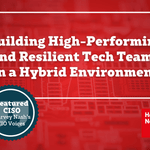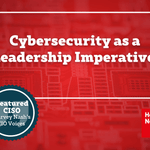Recently we hosted a virtual event discussing the top 5 things CISO’s are talking about. Each month we will be taking a deeper dive into each item. This month we are looking at topic number two, building a partnership with you vCISO and why it's important.
For many organizations it is becoming increasingly more effective and economical to utilize a virtual Chief Information Security Officer (vCISO). Involving a seasoned cybersecurity professional with a well-balanced mix of technical, operational, and business skills on a fractional basis can have dramatic positive impacts to the business.
Understandably, when we think of cybersecurity we immediately gravitate to technology and the technologists that navigate the darker corners of the environment to deal with the wide array of threats. Nevertheless, as we all have witnessed over the last decade, technology alone cannot fully address the staggering increase of cyber threats and the risk they represent as well as the business impacts they are having on companies every day.
Technology’s effectiveness, in many ways, can be directly correlated to how well it has been architected, implemented, integrated, and how aligned it is to an overall strategy. Moreover, and especially for cybersecurity, how well technology is managed, governed, reviewed, and, of course, monitored considerably contributes to effectively managing risk and compliance. Finally, without an overarching vision tied to strategic goals and defined outcomes, the cost of security technology can skyrocket, while not having clarity on risk reduction. In fact, many organizations have spent a great deal on cybersecurity only to be devastated by ransomware because of a breakdown in the program, not the technology.
All these elements are represented in the business as a security program. And as a collection of related objectives and activities performed for an established aim, its essential that is has oversight, governance, and especially leadership. Interestingly, for many organizations that oversight is not a full-time position, but rather someone that can ensure elements across investment, implementation, integration, and progression of technology are aligned and driving toward a measurable and pragmatic outcome for reducing risk and addressing compliance.
We regularly find this bonding of technology, business, and governance in the IT space, and it will typically take the form of a Chief Information Officer (CIO). CIO organizations will typically have architects, engineers, and analyst among a diverse set of technical capabilities. Moreover, there will be specific budgets tied to business outcomes that go beyond just performance, storage, or applications, such as market penetration, new service development, delivery efficiencies, customer experience, and quality improvement, to mention a few.
CIO’s are driving forward a vision, strategy, and a collection of initiatives that they are expected to not only coordinate, but to orchestrate with the demands, fiscal requirements, and operational risks set by the business. In virtually all cases they are supported by a team of specialized technical resources to perform the activities.
It’s a very similar value proposition to the business with a vCISO, and hence a very similar relationship, in having someone that can help orchestrate, plan, organize, and provide critical direction on all the necessary non-technical as well as the strategic technical aspects of security. The key difference is recognizing that it may not require a full-time resource.
The best way to get the most out of a vCISO is inclusion and collaboration in non-cybersecurity aspects of the business to ensure that the security program is aligned to business goals, objectives, and expectations, and not simply threats or technical opportunities.
Need support with your cybersecurity?
Reach out to us today! We provide access to world class senior security experts. Our vCISO Practice delivers cybersecurity results, consultative and leadership expertise to protect you and your company.




